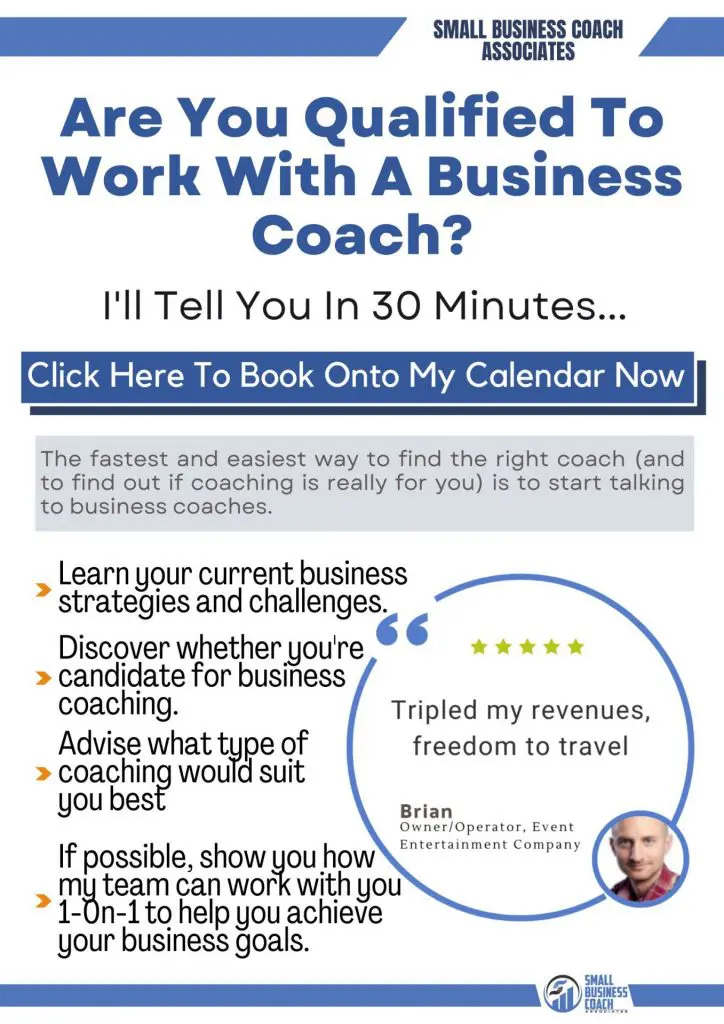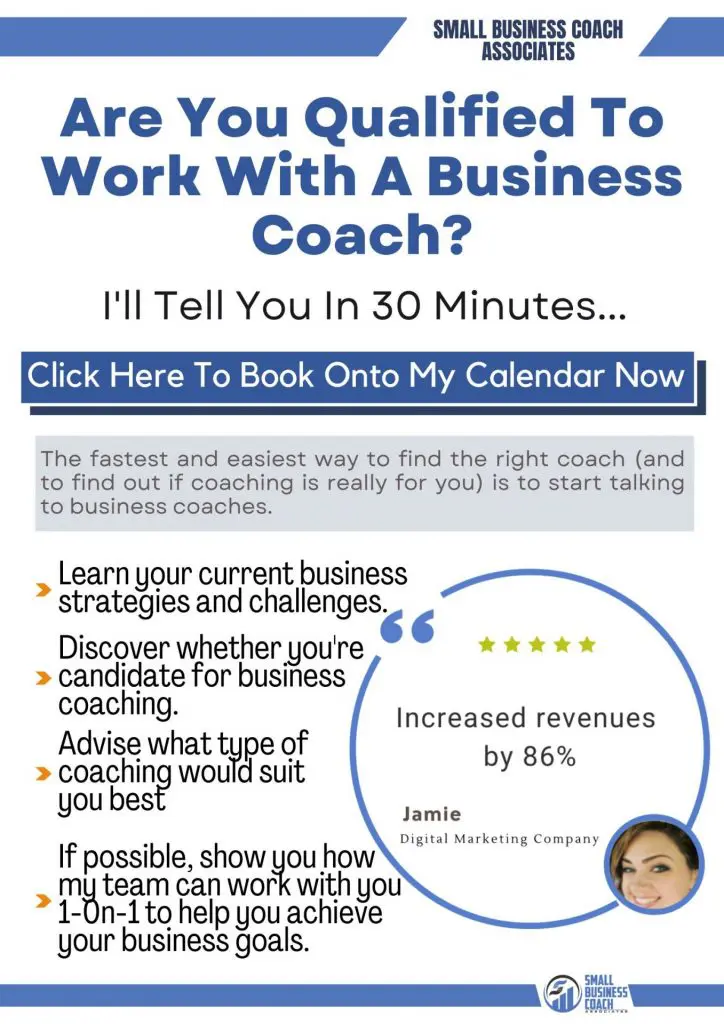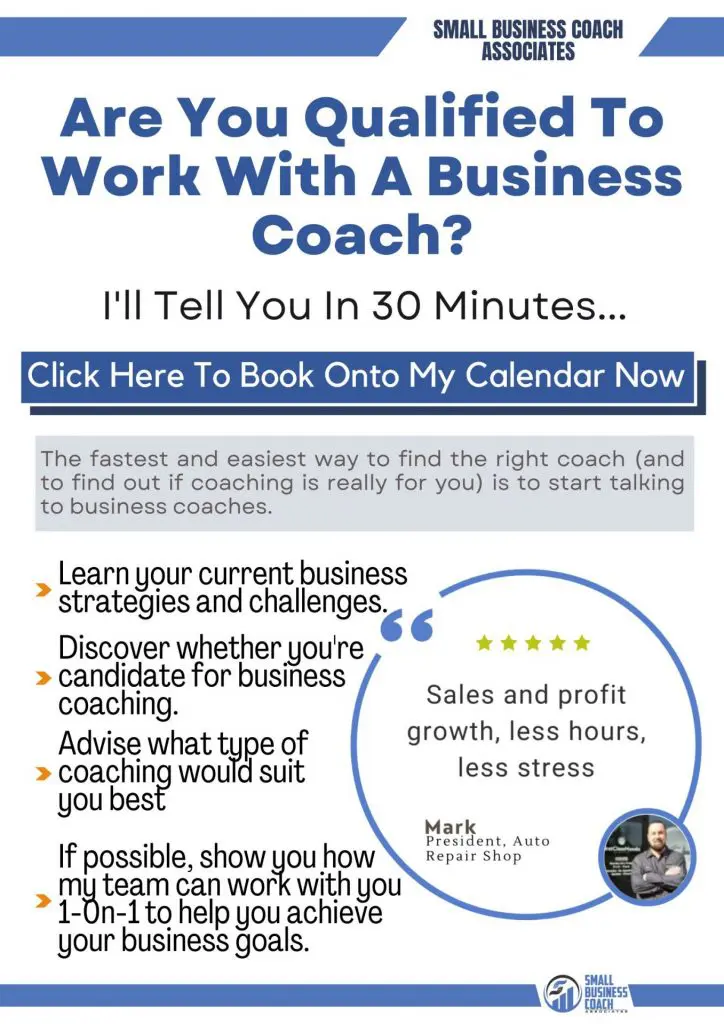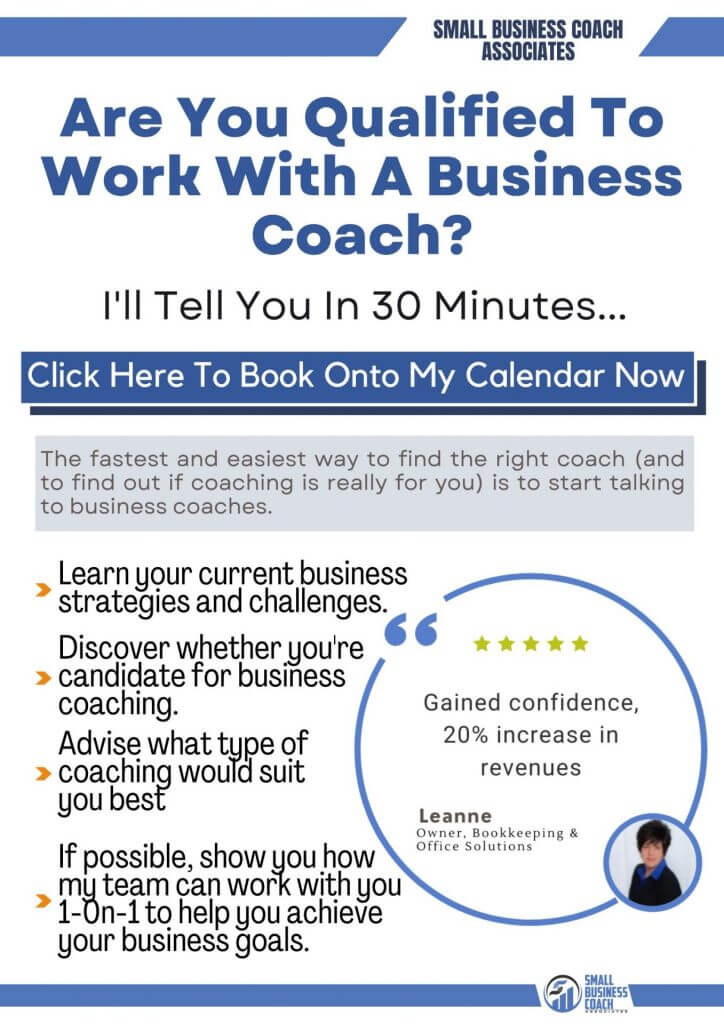As you develop in your business, you may find yourself wondering whether it would be helpful to have a coach or mentor. Both can provide valuable guidance and support, but their focus and approach differ. Here’s a brief overview of coaching vs. mentoring to help you decide which one is right for you.
Mentors are typically more experienced than their mentees and can provide advice and guidance based on their own career journeys. Mentors can help you navigate difficult situations, make essential connections, and expand your skill set.
Coaches, on the other hand, focus on helping you reach your specific goals. They work with you to develop actionable plans and hold you accountable for reaching your targets. Coaching may be the best option for you if you’re looking for help achieving a specific goal.
Both coaches and mentors can play an important role in your career development. When choosing between the two, consider your goals and what type of support you need to reach them.
Business Coaching vs. Mentoring
- Business Coaching is typically more focused on the present and future, while mentoring often looks to the past for guidance.
- Business Coaching is about helping people reach their goals, while mentoring is about sharing knowledge and experience.
- Business Coaching is often seen as more of a professional relationship, while mentoring is often more personal.
Coaching is often seen as more of a professional relationship, while mentoring is often more personal. This is because coaching typically focuses on the present and future while mentoring looks to the past for guidance. Coaches believe their clients have the answers within themselves – they need help uncovering them. Mentors, on the other hand, often share their own experiences and knowledge in order to help mentees reach their goals.
This difference can also be seen in the way coaching and mentoring relationships are viewed. Coaching is often seen as more of a professional relationship, while mentoring is often more personal.

What are the benefits of having a mentor?
There are many benefits to having a mentor. A few of these benefits are
1. You have someone to guide and advise you
A mentor can be defined as an experienced and trusted advisor. In the business world, a mentor is often more senior in their career and can offer guidance and advice to those starting out. The benefits of having a mentor are numerous, but perhaps the most important is that they can help you to avoid making costly mistakes. A mentor will have a wealth of experience and knowledge to draw upon, and they can help you to navigate the challenges of your career. They can also provide essential networking opportunities and introduce you to influential people. In short, a mentor can be an invaluable asset, and everyone should aspire to find one.
2. You have someone to help you get ahead in your career
A mentor is someone who can help guide you in your career, offering advice and support when it comes to making important decisions. Having a mentor can be incredibly beneficial, giving you access to someone who has already been successful in your field and knows the ins and outs of the industry. A mentor can help you avoid making mistakes and provide valuable networking opportunities. In addition, a mentor can help to keep you motivated and on track, ensuring that you stay focused on your goals. Ultimately, a mentor can play a pivotal role in helping you to achieve success in your career.
3. You have someone to help you learn new things
A mentor is someone who can help guide you through new and unfamiliar territory. Whether you’re just starting out in your business or you are looking to make a change, a mentor can offer advice and support. They can help introduce you to new concepts, teach you new skills, and provide support when you’re feeling challenged. A mentor can also be a sounding board for your ideas and a source of motivation when you need it. While mentors come in all shapes and sizes, finding someone with experience and wisdom you respect is the most important thing. With their help, you can learn more about your chosen field, gain valuable insights, and achieve your goals.
4. You have someone to depend on for support and encouragement
A mentor can provide support and encouragement when you need it most and can help you navigate through difficult challenges and obstacles. They can also offer helpful advice and guidance based on their experiences and knowledge. In addition, mentors can act as role models, showing you what is possible if you are willing to work hard and stay focused on your goals. If you are lucky enough to have a mentor, make sure to take advantage of all that they have to offer. It could make a big difference in your career journey.
5. You have a friend and confidante
One of the benefits of having a mentor is that you have a friend and confidante. Someone you can trust to give you honest feedback and guidance. Someone who has been there before and can help you navigate your way through challenges. If you’re feeling lost or stuck, a mentor can be the compass that points you in the right direction.
What are the benefits of having a coach?
A coach can help you achieve your goals faster and more effectively than if you were working on them alone. Coaches provide guidance, support, accountability, and expertise that can help you get the most out of your training.
Some of the benefits of having a coach include the following:
1. Improved performance and results
Most business owners would love to improve their business performance and results, but they don’t always know how to go about it. That’s where a business coach comes in. A business coach is someone who helps you take a closer look at your business and identify areas that need improvement. They will then work with you to develop strategies for making those improvements. As a result, you can expect to see better business performance and results.
2. A better understanding of your own potential and strengths
Business coaches are not only beneficial because they help you to understand your potential and strengths better but also because they can provide an objective perspective on business decisions. A business coach can help you to understand your goals and what is holding you back from achieving them. They can also help you to develop a plan of action to reach your goals. In addition, business coaches can provide accountability and support as you work to reach your goals. Having a business coach can be a powerful tool in helping you to reach your full potential as a business owner.
3. Greater motivation to train and stay focused
There are many benefits of having a business coach, but one of the most important is that they provide motivation and accountability. When you have someone to hold you accountable, it’s easier to stay focused and on track. A business coach will also push you to reach your full potential and help you overcome any obstacles that are holding you back. In addition, a business coach can offer valuable insights and advice based on their own experiences. If you’re serious about taking your business to the next level, then working with a business coach is a wise decision.
| Pro-Tip: Grab 30 minutes on my calendar to ask any questions you have about business coaching. I’ve been a business coach (and business broker) for over 20 years. I also have a business coach of my own, so I know what successful coaching looks like on both sides of the table.
~ Alan Melton, Small Business Coach Associates |
4. Optimal use of time and resources
A business coach can help business owners and entrepreneurs use their time and resources more efficiently. In today’s fast-paced business world, staying ahead of the competition and making the most of every opportunity can be challenging. A business coach can provide impartial advice and guidance on how to best use your time and resources. It can be through delegation, where business owners need to delegate certain tasks so that they can focus on CEO tasks to further improve running their business.
5. Reduced chance of making mistakes
Having a business coach provides several benefits that can help to reduce the chance of committing business mistakes. First, a business coach can offer an objective perspective on business decisions. This can be especially helpful when business owners are facing difficult choices. Second, a business coach can provide guidance and support during times of change. This can help business owners to navigate through challenging transitions without making costly mistakes. Finally, a business coach can help business owners to develop and implement effective strategies for growth. By having a business coach, business owners can benefit from expert advice and support, which can ultimately help to reduce the chance of making costly mistakes.
6. Access to expert knowledge and advice
Business coaches have extensive experience in the business world and can provide valuable insights into the challenges and opportunities that business owners face. As a result, business coaches can be an invaluable resource for business owners who are looking to take their businesses to the next level. They can guide you to develop a business plan, set goals and objectives, and improve your business skills.
Similarities of Business Coaching and Mentoring
Business coaching and mentoring can be approached in many ways, but the similarities between the two outweigh the differences. Business coaching and mentoring emphasize helping the client or mentee reach their potential by providing them with support, advice, and guidance. In business coaching, the coach takes on more of a directive role, often providing specific advice and actionable steps for the client to take. In contrast, mentoring takes a more hands-off approach, with the mentor serving as more of a sounding board for the mentee. However, business coaching and mentoring focus on helping businesses grow and succeed. As such, business coaches and mentors play an important role in ensuring that businesses are able to reach their full potential.
When does a mentor become a coach?
A mentor is someone who can offer guidance and support to someone else who is looking to improve themselves. A coach, on the other hand, is someone who offers direction and guidance in order to help an individual or group achieve a specific goal. So when does a mentor become a coach?
The answer to this question depends on the situation. In some cases, a mentor may transition into a coaching role if the person they are helping expresses an interest in becoming more actively involved in their own development. The mentor can then help them set specific goals and provide support as they work towards achieving these goals. In other cases, a mentor may act as a coach if they are asked to do so by their employer or supervisor.
Becoming a coach is a big responsibility regardless of how or when it happens. A good coach needs to be patient, articulate, and knowledgeable about the topic they are coaching on. They should also be able to foster a positive learning environment where individuals feel comfortable asking questions and making mistakes.
Three Types of Mentoring
There are three types of mentoring: traditional one-on-one, distance mentoring, and group mentoring. Traditional one-on-one mentoring is the most common type of mentoring. It involves two people meeting in person on a regular basis to discuss their lives, careers, and goals. Distance mentoring is a newer type of mentoring that involves two people communicating via phone, email, or video chat. Group mentoring is a type of mentoring that involves three or more people meeting on a regular basis to discuss their lives, careers, and goals.
Each type of mentoring has its own advantages and disadvantages. Traditional one-on-one mentoring is the most personal type of mentoring, but it can be time-consuming and expensive. Distance mentoring is less personal than traditional one-on-one mentoring but is more convenient and often cheaper. Group mentoring is the least personal type of mentoring, but having multiple mentors can be very helpful.
Four Types of Business Coaching
There are four types of business coaching: executive, integrated, team, and virtual coaching. Each type of coaching has its benefits and drawbacks, so it’s important to choose the right type of coach for your needs.
Executive coaching is perfect for business leaders who want to improve their performance and take their careers to the next level. An executive coach will help you clarify your goals, overcome obstacles and develop a plan of action. However, executive coaching can be expensive and may not be suitable for all business leaders.
Integrated coaching is a great option for businesses that want to improve their overall performance. An integrated coach will work with you to improve your communication, leadership, and team-building skills. However, integrated coaching can be time-consuming and may not be suitable for all businesses.
Team coaching is designed to help teams work together more effectively. The coach works with the team to identify its strengths and weaknesses and helps them develop strategies for improved performance.
Virtual coaching is a type of business coaching that uses technology to deliver coaching services. Virtual coaches can deliver their services via video conferencing, phone calls, or email. This type of coach can be beneficial for business owners who want the flexibility to receive coaching services from anywhere in the world. However, However, virtual coaching can have a lack of personal interaction.
| Pro-Tip: Grab 30 minutes on my calendar to ask any questions you have about business coaching. I’ve been a business coach (and business broker) for over 20 years. I also have a business coach of my own, so I know what successful coaching looks like on both sides of the table.
~ Alan Melton, Small Business Coach Associates |
How does mentoring/coaching help your business grow?
Mentoring and coaching are two essential tools for any business owner who wants to see their company grow. By mentoring, you can offer your employees guidance and support, helping them develop their skills and knowledge. This, in turn, can lead to improved performance and greater productivity. Coaching, on the other hand, is more focused on helping individuals to achieve specific goals. This could involve providing advice and mentorship on a one-to-one basis, or it could involve leading group workshops. Either way, coaching can help employees identify their strengths and weaknesses and set realistic goals to help them progress in their careers. In short, mentoring and coaching are two key ways in which you can help your business to grow.

Example of Mentoring
Steve had always been a great business owner. He was a leader, and his employees looked up to him. However, he wanted to train them to become leaders themselves, and he didn’t know how to do it. So he turned to a mentor for advice.
The mentor said. “I can give you some general tips.” He went on to share some of the best leadership practices he had learned over the years. Steve was grateful for the advice and promised to put it into practice. And so he did.
The results were impressive. His employees started taking on more responsibility and becoming more engaged in their work. They even began developing their own leadership skills! Steve was happy with the progress they were making and thanked his mentor for all of his help.
Through mentoring, Steve was able to:
- Save time and energy
- Get expert advice and learn leadership skills.
- Receive support and encouragement to navigate difficult challenges.
- Achieve goals and expand knowledge in a shorter time frame.
Example of Business Coaching

As Jane contemplated her situation, she knew she needed to make a change. She was working 111 hours a week and wasn’t able to spend any time with her family. It was taking its toll on her mentally and emotionally. So she decided to get a business coach to help her manage her time more effectively and systematize her business.
At first, the changes were difficult. But after following her coach’s advice diligently, Jane began to see results. She was able to cut down on the number of hours she worked each week from 111 hours down to 47.5 hours while maintaining and even growing her business. Best of all, she was now able to spend more time with her family and enjoy life again.
Through coaching, Jane was able to:
- Reduce the number of hours worked each week
- Maintain and grow business while spending more time with family
- Systemize business for long-term success
- Decrease stress and increase productivity
Business Coaching vs. Mentoring: Which one is best for you?
When it comes to personal and professional development, coaching vs mentoring is two popular approaches. But what’s the difference between the two? And more importantly, which one is right for you?
Mentoring typically involves a more experienced individual passing down wisdom and advice to someone who is less experienced. The mentee looks up to the mentor as a role model and seeks guidance on how to navigate their chosen field. Coaching, on the other hand, is more focused on helping the client reach specific goals. The coach acts as a sounding board and provides support and accountability, but ultimately it’s up to the client to figure out the best way to reach their objectives.
So. coaching vs mentoring, which one should you choose? Mentoring may be a good option if you’re feeling lost and uncertain of your next steps. But coaching could be a better fit if you’re clear on what you want to achieve and just need some help getting there. Ultimately, the best way to decide is to experiment with both approaches and see what works best for you.
Conclusion
When it comes to coaching and mentoring, there is no one-size-fits-all answer. The best approach depends on your specific needs and goals. This article explores the differences between coaching and mentoring and helps you decide which is best for you.
Coaching and mentoring are both forms of developmental support. They can both be helpful in achieving your goals, but there are some key differences. coaching is typically more task-oriented, while mentoring is more relationship-oriented. Coaching focuses on the present and future while mentoring often looks to the past for guidance. Mentors may also provide coaching, but their primary focus is developing long-term relationships.
So, which one is right for you? Coaching may be the best option if you’re looking for help with a specific goal or task. Mentoring may be the way to go if you’re seeking guidance and wisdom from someone with more experience. Ultimately, the decision comes down to what you’re hoping to achieve.


































 You Can Have Greater Control Over Your Website if You Build it Yourself
You Can Have Greater Control Over Your Website if You Build it Yourself





